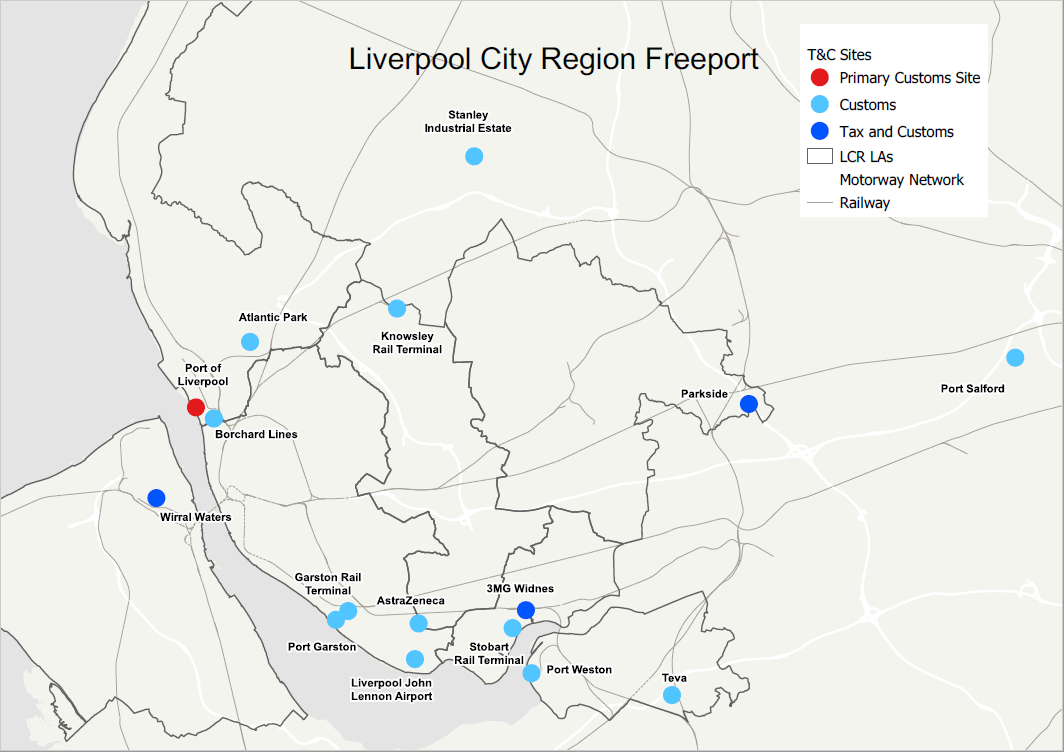Liverpool City Region’s Freeport is now open, but what exactly is it?
Posted on: 12 January 2023 by Tom Arnold in Blog

Liverpool City Region’s (LCR) new freeport has received sign-off from the government, following approval of its full business case earlier this week.
Liverpool City Region’s (LCR) new freeport has received sign-off from the government, following approval of its full business case earlier this week. LCR was selected in 2021 as one of eight areas in England to develop a freeport and, over the last two years, the freeport team has worked with LCR Combined Authority (LCRCA), the six local authorities, and private sector partners to develop the plans. LCR Mayor Steve Rotheram said the freeport could “attract international investment, create more well-paid, highly skilled jobs for local people and build on our existing strengths”, with LCRCA estimating it will add £850m to the local economy and create 14,000 new jobs.
So what exactly is the freeport, and how might it achieve these objectives?
Freeports are a type of special economic zone (SEZ), usually located in coastal areas. Businesses within these zones are generally subject to different tax, customs or planning rules than those based outside. There are currently dozens of freeports across the world, subject to a wide variety of tax and customs regulation. Businesses located within the Jebel Ali Freeport in Dubai, for example, pay almost no tax at all, and duties are not applied to imports and exports.
Deregulation within the UK’s new freeports is comparatively low key. Benefits for businesses vary between the different freeports, but in LCR cover three main areas.
Tax. Businesses located within three tax sites at Parkside (St Helens), 3G (Widnes) and Wirral Waters can benefit from relief on Business Rates, Stamp Duty Land Tax and, for certain employees, National Insurance. Tax sites will also provide enhanced capital allowances for companies investing in plant and machinery.
Customs. Businesses located in 16 sites, including the three tax sites, the primary freeport site at Port of Liverpool, and two outside LCR (one in Salford and one in West Lancashire) will benefit from simplified customs procedures and tariff-free imports.
Planning and regeneration. A series of infrastructure investments will be made as part of the freeport’s development, including a rail freight interchange at Parkside. There are also likely to be improvements to the road network to facilitate additional freight traffic
There is some flexibility for freeports to focus on local strategic priorities, and local leaders will play a role in shaping the development of each freeport. In LCR, the mayor and freeport leadership team have emphasised two key priorities – providing high-quality employment opportunities, and contributing to the region’s 2040 net zero target. Employers located at freeport sites will be asked to commit to the LCR Fair Employment Charter, and there are particular opportunities to support the hydrogen technology sector which is already a significant local presence.
While appearing something of an experiment, the UK’s new programme of freeports is in fact the latest in a long line of attempts to concentrate economic activity in areas which have experienced post-industrial change. In Liverpool, the Merseyside Development Corporation was integral to redeveloping the docks during the 1980s and 1990s. More recently, Enterprise Zones were established at Mersey Waters and Sci-Tech Daresbury under the 2010-15 Coalition Government. Evidence for whether these kinds of area-based initiative generate significant positive economic impacts is mixed, with a review of Enterprise Zones highlighting the risks of displacement – employers moving activity to the zones to benefit from tax breaks, rather than creating new jobs. LCR freeport management have focused particularly on attracting new employers from outside the region, with significant interest particularly from potential occupiers in the automotive sector. Nevertheless, ensuring activity within the sites provides additional value will be an ongoing task for freeport management over the next few years.
Perhaps the most intriguing element of the freeport, however, is its geography. The spread of activity across multiple sites, spanning all six local authorities across LCR, provides scope to improve supply chains and promote benefits from agglomeration. While Liverpool has transitioned to a more service-based economy over recent decades, manufacturing and logistics remain central to the wider region’s economic future. LCR now has a public-private partnership with powers and funding (albeit limited) to coordinate investment in strategic industrial assets across the region.
It is important to be wary of boosterist claims for any single regeneration policy, and the freeport will not be a silver bullet to improve Liverpool City Region’s productivity and economic prospects. However, as part of a wider policy mix there is potential to shape the freeport to reflect local priorities and impact positively on local economic outcomes.
Keywords: .